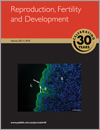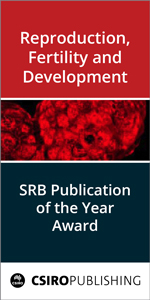Reproduction, Fertility and Development
Volume 30
Number 11 2018
Mammalian spermatozoa remain immotile and quiescent inside the cauda epididymidis for several weeks without compromising their fertility. Hence, cauda epididymal plasma (CEP) may improve sperm preservation in vitro. The protein fraction of CEP was found to be responsible for sperm quiescence and both15% and 20% (v/v) CEP improved sperm characteristics following 48 h liquid preservation. Therefore, recombinant CEP proteins have great promise in sperm preservation.
Growth restriction in humans can be identified by monitoring umbilical blood flow by ultrasound. This study presents novel relationships between umbilical blood flow in the pig and both fetal weight and the sex ratio of the litter. In addition, maternal sedation early in pregnancy decreased fetal weight in late pregnancy. It is hoped this method of Doppler ultrasound under light sedation could be used further to improve our understanding of the mechanisms governing fetal growth in the pig.
Eleven captive female southern hairy-nosed wombats were trained to urinate on command. The samples collected were analysed for reproductive hormones, physical characteristics and cytology. When progesterone levels were low, sample volume was low, whereas sample concentration and epithelial cell concentration were high, indicating potential markers that may be used to monitor the reproductive status of females in captivity.
Infrared cameras were used to record the behaviour of captive female southern hairy-nosed wombats. The recorded behaviours were compared against urinary reproductive hormone profiles to identify behavioural changes associated with reproduction. Females appeared more agitated and paced more prior to an increase in progesterone, suggesting that these changes in behaviour could be used to monitor the reproductive status of captive females.
In mammals a causal relationship between postcopulatory sexual selection and relative testes mass occurs but how much it determines sperm shape and size is debatable. Here we determined the relationship between relative testes mass and sperm form within the largest tribe of murid rodents – the Rattini. We found that relative testes mass correlates with the length and angle of the sperm head apical hook as well as its tail length. We concluded that sexual selection is a major selective force in driving sperm head form within this subfamily of mammals.
Serial cloning is a critical tool for expansion of transgenic lines or for resetting the lifespan of transgenic cells. This is the first study that determined the effect of serial cloning on cloning efficiency and DNA methylation patterns of imprinted genes in goats. Our results provide additional insights into cellular reprogramming and the importance of imprinted genes for development.
Decidual prolactin expression is promoted by exchange protein directly activated by cAMP (EPAC)-mediated cAMP signalling in human endometrial stromal cells but the mechanism of its upregulation has not been well characterised. EPAC signalling activates CCAAT/enhancer-binding protein (C/EBP) response elements in the promoter region of the prolactin gene during the process of decidualisation. EPAC may play a pivotal role in endometrial decidualisation necessary for pregnancy.
Temperature matters: an environmental temperature increase triggers a specific spermatozoa hypermotility pattern, which is essential for fertilisation. The temperature-induced hypermotility is accompanied by intracellular calcium release; however, it is independent of extracellular calcium or PKA activity. Temperature as stimulus helps to understand how spermatozoa regulation occurs through the female reproductive tract to accomplish oocyte fertilisation.
As spermatozoa move along the epididymis, they are coated in a series of proteins, including several members of the β-defensin family. Similar to the role of its analogue in the macaque, the present study has demonstrated that β-defensin 126 increased the ability of bovine spermatozoa to bind to the oviductal epithelium. This has the potential to increase the fertile longevity of spermatozoa in the female reproductive tract.
The present study investigated changes in the luminal uterine epithelium during early pregnancy in the rat. Two cytoskeletal proteins, palladin and lasp-1, were found to increase and change localisation during the time of implantation when compared to the time of fertilisation, indicating a role in uterine receptivity. This work contributes to the current understanding of how uterine luminal epithelial cells transform to facilitate successful blastocyst implantation during pregnancy.
Fertilisation rate is reduced when mice receive high fat diets with high ω6 : ω3 ratio from gestation until adulthood. An increased percentage of immature gametes and alterations in sperm membrane integrity are found without significant changes in the oxidative status. Sperm quality can be improved, not only by modifying the consumption of fatty acids in male mice, but also that of their mothers, reducing the ω6 : ω3 ratio.
Primordial follicle growth or activation is under the control of several paracrine factors such as insulin-like growth factor 1 (IGF-1). This study investigated the effects of IGF-I on ovine ovarian tissue culture and it demonstrated that IGF-1 promoted activation through the PI3K/AKT signalling pathway. Controlling the levels of specific signalling members in the follicle culture can lead to retrieval of oocytes with an enhanced developmental potential.
The sperm mitochondria of turtles possess a unique kind of morphology that is commonly known as ‘onion-like mitochondria’. This is the end product of mitochondrial remodelling and was achieved after the mitochondria had passed through six different morphological types during spermiogenesis. Because mitochondria show great morphological diversity in response to physiological and pathological conditions, this normal transformation of mitochondria could be a good model in which to study different mitochondrial morphologies associated with disease.
Supplementation of both NCG- and RP-Arg increased fetal mass and alleviated fetal thymus development and immune function in response to IUGR. The positive effects of these dietary supplements were accompanied by structural changes and increased proliferation, as well as reduced apoptosis and oxidative stress. Further research into the molecular mechanisms underlying the beneficial effects of NCG and RP-Arg in regulating conceptus growth and development is warranted.
Decay accelerating factor (DAF) plays a role in protecting the fetus from maternal complement injury in the endometrium. We demonstrated that E2-dependent DAF expression is antagonised by P4–progesterone receptor signalling in the uterine epithelium. Additionally, we showed the spatiotemporal regulation of DAF during periimplantation period. This study indicates that DAF functions as an immune modulator for embryo implantation and early pregnancy in mice.
The interval from luteolysis to ovulation (pro-oestrus length) influences fertility in beef cattle. This study demonstrates that extending the length of pro-oestrus before fixed-time AI (FTAI) promotes preovulatory follicular growth, increases postovulatory progesterone levels and improves the pregnancy rate. We propose a new protocol for FTAI (the J-Synch protocol) to achieve this goal in beef heifers.
Lipolytic conditions, reflected in follicular and oviductal fluid, are an important causative link between metabolic disorders and reduced bovine oocyte and embryo development, but the link with sperm functionality and fertilisation has still to be elucidated. We show evidence that high fatty acid levels affected the fertilisation process mainly through an effect on the oocyte. Although sperm function was reduced, spermatozoa retained their fertilising capacity. These data provide the first insights into the impact of a metabolically compromised environment on both oocytes and spermatozoa and their interaction.
Fragile X-related protein 1 (FXR1) regulates the stability of multiple targets that have important biological roles. However, the role of FXR1 in trophoblasts at the maternal–fetal interface remains poorly understood. Our findings identify a novel function for FXR1 in trophoblasts via destabilisation of COX-2 mRNA. This study reveals a new pathway governing the regulation of FXR1 and COX-2 in trophoblast function during early pregnancy.
We reported previously that the testis-specific isoform of angiotensin-converting enzyme (tACE) is involved in regulation of bovine sperm capacitation. In the present study, we investigated the effects of cryopreservation procedures on the content and activity of tACE in bull spermatozoa. The results suggest that cryopreservation-associated decreases in the content and activity of tACE may contribute to the reduced fertility of frozen–thawed bull spermatozoa.
The testis-specific isoform of angiotensin-converting enzyme (tACE) is involved in the regulation of bull sperm capacitation. In this study we investigated the relationships among tACE content and activity in frozen–thawed Holstein bull spermatozoa and field fertility. tACE content and activity were significantly and positively associated with field fertility, suggesting tACE as a marker for bull fertility.




